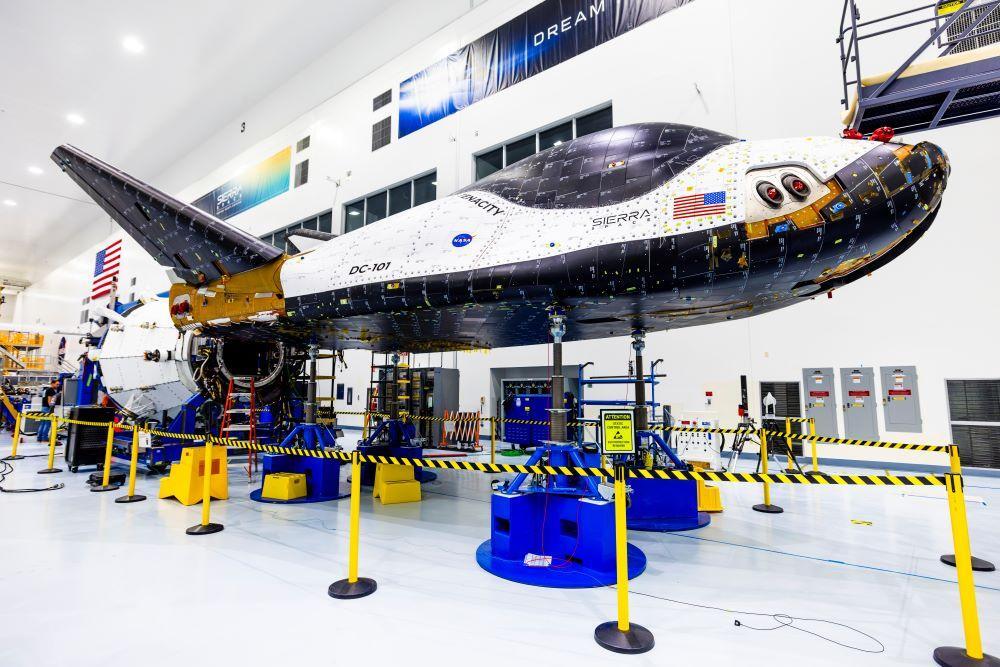24.10.2025

Dream Chaser Tenacity in its processing hangar at NASA's Kennedy Space Center in August.
For the last 18 years, privately owned Sierra Nevada Corp. has been pitching NASA on plans to develop and fly a winged vehicle, named Dream Chaser, which evolved from the agency’s HL-20 lifting body designs of the 1990s.
Between 2010-12, Sierra Nevada won three rounds of funding for Dream Chaser, totaling more than $325 million, under the NASA Commercial Crew Development program. When the agency instead chose crew vehicles from SpaceX and Boeing for flight services, Sierra Nevada repositioned Dream Chaser for cargo missions and in 2016 won a contract for at least six resupply runs to the International Space Station (ISS).
But Dream Chaser’s debut, originally targeted for 2021, has been repeatedly delayed. Its first flight is now not expected until late 2026. ISS is due to end in 2030.
With the clock ticking, NASA and Sierra Nevada’s spinoff company Sierra Space last month said they had mutually decided to nix Dream Chaser’s ISS cargo runs and conduct a free-flying demonstration mission instead. The contract modification, announced Sept. 25, canceled NASA’s commitment to purchase flights to the ISS, but left the option open to add resupply missions following the Dream Chaser debut.
In an interview with Aviation Week, Sierra Space says ending its commitment to fly NASA cargo was the fastest path to first flight. “We were mutually aligned to modify the contract,” said Dan Polis, vice president of Engineering Solutions and Propulsion Systems and Dream Chaser program manager. “We have been working closely with NASA on a path, and we felt that we were ready to fly ... This was favorable for us to get to first flight more quickly.
“We feel as though the vehicle and our verification paperwork is in good shape,” he added. “We have a 30-year history of developing spaceflight hardware—dozens of satellites, 100% success—so we know how to certify flight hardware. We’ve done it, and we feel like the vehicle is in good shape on the path to flight certification. But I can’t speak to NASA and their level of comfort with us getting to station.”
Instead of flying some 7,800 lb. of cargo to the ISS for NASA, Sierra Space is looking for other customers for Dream Chaser’s first flight, which potentially could include satellite deployments from the vehicle’s unpressurized cargo module.
The free flight “gives us flexibility to use the vehicle … to support national security, as well as NASA and commercial partners,” Polis said. “We’ve already begun conversations with both civil and national security customers.
“The market ... needs providers of cargo and other services,” he added. “Dream Chaser is an excellent, flexible platform to bring up cargo—pressurized and unpressurized —and return. It also serves as an orbital hypersonic testbed where you can test ground systems and/or test technology. I think Dream Chaser offers a significant place in the market.”
In a statement, NASA said, “As NASA and its partners look toward space station deorbit in 2030, this mutually agreed to decision enables testing and verification to continue on Dream Chaser, as well as demonstrating the capabilities of the spaceplane for future resupply missions in low Earth orbit.”
NASA had already issued firm-fixed price task orders for four Dream Chaser resupply missions to the ISS. NASA and Sierra Space both declined to say how much money has been spent so far, and if taxpayers were due a refund.
“We can’t talk specifics on funding and milestones,” Polis said, but added that the contract “realigned future commitments to support the demo flight.”
Sierra Space met one of those milestones last week when Dream Chaser completed electromagnetic interference and compatibility testing at NASA’s Kennedy Space Center (KSC). A captive tow test on the KSC runway is planned for the second week of November. That would be followed by acoustic testing in the KSC Space Station Processing Facility.
Other milestones ahead of flight are an integrated hot-fire test and an integrated hardware/software mission systems test, Polis said.
Tenacity, the first Dream Chaser vehicle, arrived at KSC in May 2024, in preparation for a launch that had been expected later that year.
For Dream Chaser’s rescheduled Q4 2026 debut, Sierra Space still plans to fly on a United Launch (ULA) Alliance Vulcan rocket, but is considering alternatives for future flights. “ULA has been a great partner, but we are actively considering other possibilities, depending on customer need,” Polis said. “But it’s a tight partnership, and so very preliminary for us to consider anything else.”
Dream Chaser is now expected to launch into an ISS-like, low Earth orbit where it will spend several days demonstrating flight control and other systems before a key test of the vehicle’s entry, descent and runway landing.
The reusable Dream Chaser is 30 ft. long—approximately the same size as the U.S. Space Force’s X-37B spaceplane—but with a 23-ft. wingspan, compared to X-37B’s 15-ft. wingspan. Dream Chaser, which features a disposable cargo module, has far more payload capacity than the Boeing-built X-37B.
Sierra Space’s former agreement with NASA called for cargo deliveries up to 11,500 lb. per flight and missions at the ISS lasting up to 75 days.
Sierra Space is in early production of a second Dream Chaser spaceplane, named Reverence, at the company’s Louisville, Colorado, facility. Sierra Space previously planned a crewed Dream Chaser variant, known as the DC-200 series, and a national security vehicle, the DC-300, but those programs are no longer active, the company said.
Quelle: AVIATION WEEK
